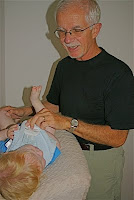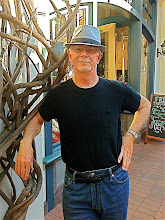Having said that, here's what I like. I like my old-style hotel, the Museumzicht, with its steps (to my fourth floor monastic cell) as steep as a housepainter's ladder. I stayed here two years ago with Carol, and didn't even look for a better hotel this time. Friendly staff, a nice breakfast in a sunny room with big windows, shared toilet and shower - the old-fashioned way. My tiny room with a tiny window (I call it my air hole) on the top floor is just right for me. The toilet is so tiny that it makes me long for the luxurious bifs on the airplane. And the shower is even smaller. (Really. No plus sizes here, please.) But it's all clean, well-managed and, as I noted, friendly.
Breakfasts at the Museumzicht haven’t changed in two years - a boiled egg, dark bread, white bread, honey, jam, a slice of ham, a slice of cheese, a personal pot of coffee, a thimble-sized class of orange juice. Delicate, but oddly satisfying. In addition, the bread basket contained a prepackaged slice of bread labeled “Roggebrood.” As I looked at it, I was certain that it looked chocolate-coated. Certain, as in so sure that I ripped off the wrapping and bit into the treat. What I tasted was not chocolate, but something that might have been carried through the northwoods by voyageurs two hundred years ago. Like pemmican. Or jerky (without the salty taste). But sure to last for months without going bad. I had thought that “brood” must mean bread, but I think the correct translation is “board.” And “rogge?” Well, my guess now is either “particle” or “rugged.”
I like being across the street from the city's two showcase museums, the Rijksmuseum and the Van Gogh Museum (the Dutch say Van Hhhhock - you sort of growl the h's). The former is full of old masters. The Van Gogh is a gem of a museum, a work of art itself, the building designed so as to display paintings in a way that accentuates their beauty and to allow people to flow freely through the exhibit. It is an homage to Vincent Van Gogh.
I was in line for the Van Gogh Museum twenty-five minutes before its ten o'clock opening. It was a bit of a wait, but at least I was able to count the people in front of me (about thirty) and not the blocks in front of me, like the people who showed up at ten. (I'm not quite sure why I didn't get my ticket online to avoid this. Sloppy planning, I suppose.)
On Saturday, after visiting the Rijksmuseum, as I wandered on Museumplein, I began to feel blue. I know part of the mood was being alone in a strange city after nine days surrounded by people I love. I think also that perhaps it's part of traveling alone; sometimes you just feel, well, lonely. It's like a cold. You get it; it passes.
 Bicycling appears to be the preferred mode of transportation in Amsterdam.
Bicycling appears to be the preferred mode of transportation in Amsterdam. The canals invite you to wander all day, which I did.
The canals invite you to wander all day, which I did. Sunday was wet, but I didn't mind at all.
Sunday was wet, but I didn't mind at all.I like wandering through the city - the quiet streets of Jordaan neighborhood, where it still feels like the nineteenth century; the busy streets of the Leidseplein with its restaurants, street performers, trams and crowds; the canals, of course, with the allure that any body of water holds; the Vondelpark on a Sunday afternoon, full of families, joggers, cyclists; the flower market.
 The flower market. Got bulbs? If not, here they are.
The flower market. Got bulbs? If not, here they are.
 The flower market is a place to be on Sunday afternoon.
The flower market is a place to be on Sunday afternoon.
 The flower market. Got bulbs? If not, here they are.
The flower market. Got bulbs? If not, here they are. The flower market is a place to be on Sunday afternoon.
The flower market is a place to be on Sunday afternoon.Okay. Food. I grant that there may be good cuisine to be found in Amsterdam. It is a major city, after all. Perhaps I was just too cheap to spring for a good meal. But really, you shouldn't have to spend a hundred bucks (or euros or yuan or kroners or pflergs). Paris has its street vendors offering luscious crêpes. Philly has cheesesteaks and hoagies. D.C. has Mama Ayesha's. Even Minneapolis has the tasty "Mini-tin" sandwich at Tin Fish. After two visits here, I still haven't found the good cuisine. What I've found is fuel to get you through the day. Last night I had pasta. It was linguine; of this I'm sure. With pine nuts, I am certain. Parmesan? Perhaps. The pesto? Hmmmm. I suspect I had backpacker's powdered parmesan and pesto. I ate it all. A guy gets hungry.
On the other hand, every waiter, waitress and bus person I encountered here was cheerful and friendly to a fault. You had to be happy in the restaurants, even if the food made you long for an airlines snack pack. My waitress at the pasta place was sooooo happy to see me at last. (Perhaps, now that I think of it, she may have visited an Amsterdam coffee shop before work. Heh. Heh. You know, where they sell pot, man. Weed. Grass.) If she had ever learned to use indoor vs. outdoor voice, her knowledge was not evident this night. The way she repeated “Linguine al pesto” so that the people on the lower floor (and perhaps passersby on the street) knew what I was having made me hope that she never moves on to a job selling personal hygiene products.
On the way back to my hotel, I wandered into Amsterdam’s version of a Seven-Eleven convenience store, where for one euro fifty I scored a Dove Caramel Liaison bar. Oh my! Was it ever so good! Oh! Mmmmmm! Oh! As I savored my last bite, I thought hard about turning around and going back to buy several more. Mmmmm.
At the bottom of the pasta bar's menu was printed the restaurant’s “House Rules.”
Welcome to all ethnics.
No smoking.
Let staff advice you on best quality experience. (Don’t eat ‘til you’re on your plane.)
Tourists: No dope smoking.
Rules to live by, indeed.
On the other hand, every waiter, waitress and bus person I encountered here was cheerful and friendly to a fault. You had to be happy in the restaurants, even if the food made you long for an airlines snack pack. My waitress at the pasta place was sooooo happy to see me at last. (Perhaps, now that I think of it, she may have visited an Amsterdam coffee shop before work. Heh. Heh. You know, where they sell pot, man. Weed. Grass.) If she had ever learned to use indoor vs. outdoor voice, her knowledge was not evident this night. The way she repeated “Linguine al pesto” so that the people on the lower floor (and perhaps passersby on the street) knew what I was having made me hope that she never moves on to a job selling personal hygiene products.
On the way back to my hotel, I wandered into Amsterdam’s version of a Seven-Eleven convenience store, where for one euro fifty I scored a Dove Caramel Liaison bar. Oh my! Was it ever so good! Oh! Mmmmmm! Oh! As I savored my last bite, I thought hard about turning around and going back to buy several more. Mmmmm.
At the bottom of the pasta bar's menu was printed the restaurant’s “House Rules.”
Welcome to all ethnics.
No smoking.
Let staff advice you on best quality experience. (Don’t eat ‘til you’re on your plane.)
Tourists: No dope smoking.
Rules to live by, indeed.



























































